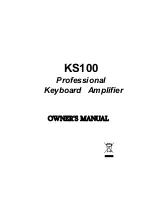
12.Record out: These sockets allow the user to record their performance through the amp.
Using standard RCA cables, these outputs can be connected to a variety of
recording equipment.
13.Phones: This is the headphone output which is great for quiet practice.
14. Power: This switch controls the supply of AC power to the amplifier.
Rear panel
1 .AC Socket: This is the socket that supplies the AC power. The supplied power
cable fits into this socket and plugs into an AC power outlet. Do not use the
power cable if it is damaged in any way.
2.Ground Lift: This switch is used when using the Dl out (6).It is only used to eradicate
noise in the signal.
3.External Speaker: This output allows you to connect another speaker to the amplifier
which makes the amplifier very flexible. Be very careful when attaching another
speaker. Ensure that the reverb is off.
4.Foot switch: Plug a single button foot switch( FS100) into this socket. This
allows the user to turn the reverb on and off.
5.Effects loop: This allows an external effects unit to be attached to the amplifier. This
is generally used for rack mounted effects such as reverb or multi effects.
NB If using floor effects for guitar, the best set-up is an in-line configuration.
6.DI Out: This allows the amplifier to be easily connected to PA or recording equipment,
using a balanced XLR cable.
Features at a glance
*15" speaker&piezo flare horn
*5 band graphic EQ
*Combo(XLR&1/4" jack)&jack input
*Reverb with individual channel control
*Spring reverb (footswitchable)
*Master volume control
*Record output (RCA)
400 WATTS
^channels
"Dl output
"Line out
"Effects loop
"Headphone output
"Extension speaker






















